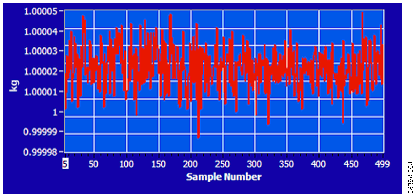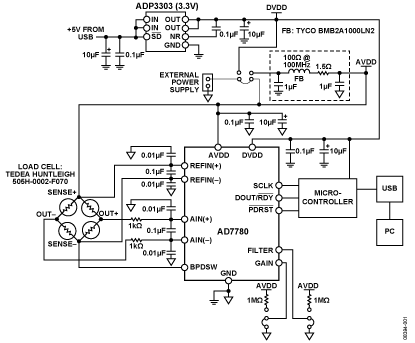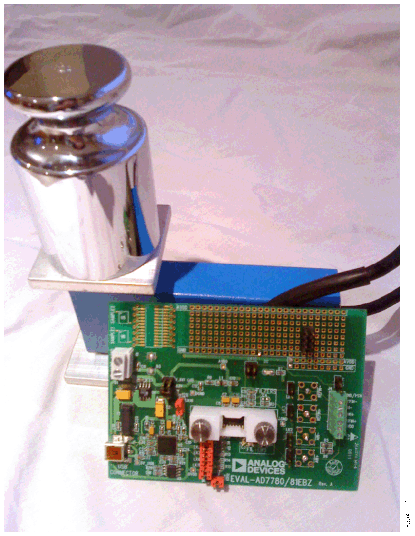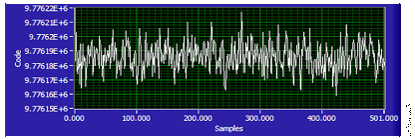This circuit is a weigh scale system built using the AD7780 . The AD7780 is a pin-programmable, low power, low drift, 24-bit Σ-Δ ADC with built-in PGA and internal clock. The device simplifies the design of a weigh scale by placing most of the system building blocks on the chip. The typical power consumption of the device is only 330 μA, which is suitable for all low power or battery-powered applications. The AD7780 also provides a power-down mode, which allows the user to cut off the power to the bridge sensor and put the device into power-down mode when no conversion is being performed, thereby extending the battery life.
Design of a weigh scale using the AD7780, a 24-bit Σ-Δ ADC with built-in PGA
|
|
|
Figure 1. Weigh Scale System Using the AD7780 (Simplified Schematic: All Connections Not Shown) |
Circuit DescriptionThe
AD7780 provides an integrated electronic scale solution that can directly interface with the weighing sensor. Electromagnetic shielding (EMC) requirements can be met by using only some filters on the analog input and some external components such as capacitors on the reference voltage pins. The low-level signal from the weighing sensor is amplified by the built-in PGA of the AD7780. The PGA is programmed to operate with a gain of 128. The conversion result of the AD7780 is sent to the PC through the USB interface, and the PC converts the digital information into weight.
Design of an electronic scale using the AD7780 24-bit Σ-Δ ADC with built-in PGA
|
|
|
Figure 2. Weigh Scale System Setup Using the AD7780 |
Figure 2 shows the actual test setup. For optimal system performance, a 6-wire load cell was used. In addition to the excitation, ground, and 2 output connections, a 6-wire load cell has 2 sense pins. These sense pins are connected to the high and low sides of the Wheatstone bridge. Therefore, the voltage developed across the bridge can be accurately measured despite the voltage drop caused by the wiring resistance. In addition, the AD7780 has a differential analog input that accepts a differential reference voltage. The load cell differential SENSE lines are connected to the AD7780 reference voltage inputs to form a ratiometric configuration that is not affected by low frequency variations in the power supply excitation voltage. If a 4-wire load cell is used, there is no sense pin and the ADC reference voltage pin is connected to the excitation voltage and ground. In this configuration, there will be a voltage drop between the excitation voltage and SENSE+ due to the wiring resistance, so the system is not completely ratiometric. In addition, there will be a voltage drop due to the wiring resistance on the low side.
The AD7780 has separate analog power supply pins and digital power supply pins. The analog and digital supplies are independent from each other, so AVDD and DVDD can be at different potentials. The microcontroller uses a 3.3 V supply. Therefore, DVDD is also powered by a 3.3 V supply. This eliminates the need for external level shifting, which simplifies the interface between the ADC and the microcontroller. The 3.3 V digital supply can be generated using the ADP3303 regulator.
There are several ways to power the weigh scale system, such as using the main power bus or using the ADP3303 (3.3 V). When the weigh scale is excited with 5 V, the main power bus must be used. When the load cell is excited with 3.3 V, the main power bus or the ADP3303 (3.3 V) can be used. The ADP3303 (3.3 V) is a low noise regulator. In addition, noise reduction capacitors are placed on the regulator output as recommended in the ADP3303 (3.3 V) data sheet. To optimize electromagnetic shielding, the regulator output is filtered before powering the AD7780 and the load cell. Since any noise on the power or ground planes will introduce noise into the system and degrade the circuit performance, the power supplies for the AD7780 and the load cell must be generated by low noise regulators.
If a 2 kg load cell with a sensitivity of 2 mV/V is used, the full-scale signal from the load cell is 10 mV with an excitation voltage of 5 V. Load cells have an associated offset voltage or TARE. The magnitude of this TARE can be up to 50% of the full-scale output signal of the load cell. Load cells also have a gain error of up to ±20% of full scale. Some customers use a DAC to remove or offset the TARE. If the AD7780 uses a 5 V reference voltage, its analog input range is equal to ±40 mV when the gain is set to 128. The wide analog input range of the AD7780 relative to the full-scale signal of the load cell (10 mV) helps ensure that the offset voltage and gain error of the load cell do not overload the ADC front end. [page]
When the output data rate is 10 Hz, the rms noise of the AD7780 is 49 nV. The number of noise-free samples is equal to

The factor 6.6 is used to convert the rms voltage to peak-to-peak voltage.
Therefore, the resolution in grams (g) is equal to

Noise-free resolution is equal to

In practice, the load cell itself introduces some noise. The drift of the AD7780 also causes some drift in the load cell over time and temperature. To determine the accuracy of the complete system, the scale can be connected to a PC via a USB connector and the performance of the scale system can be evaluated using LabView software. Figure 3 shows the output performance measured by placing a 1 kg weight on the load cell and collecting 500 conversion results (using a 5 V excitation voltage). The software calculates the system noise to be 50 nV (rms), which is equivalent to 30,300 noise-free samples or 14.9 bits of noise-free code resolution.
Designing a Weigh Scale Using the AD7780 24-Bit Σ-Δ ADC with PGA
|
|
|
Figure 3. Output code measured with 500 samples, showing the effects of noise. |
Design of electronic weigh scales using the AD7780 24-bit Σ-Δ ADC with built-in PGA
|

|
|
Figure 4. Output measured in kilograms for 500 samples, showing the effects of noise. |
Figure 4 shows the performance in terms of weight. The peak-to-peak change in the output over 500 codes is 0.075 grams. Therefore, the accuracy of this weigh scale system is 0.075 grams.
The figure above shows the actual (raw) conversion results read back from the AD7780 after the load cell is connected. In practice, a digital post filter is used in a weigh scale system. Additional averaging in the post filter will further increase the number of samples, but the data rate will be reduced.
Common Variations
Note: The noise specifications in this article are for a PGA gain of 128.
The AD7780 is a low noise, low power ADC suitable for weigh scale designs. Other suitable ADCs are the AD7798 and AD7781. The AD7781 has the same feature set as the AD7780, but is a 20-bit ADC. The AD7798 has a wider range of output data rate options. Its rms noise is 40 nV at 4.17 Hz.
The AD7799 is suitable for mid-range weigh scales. The AD7190, AD7192, and AD7191 are suitable for precision weigh scale designs. The AD7190 has an rms noise of 8.5 nV when the output data rate is set to 4.7 Hz.
It also has a wide output data rate range. It can operate up to 4.8 kHz while still maintaining good performance. The AD7192 is pin-compatible with the AD7190, but has a slightly higher rms noise. The AD7192 has an rms noise of 11 nV when the output data rate is 4.7 Hz. The AD7191 is a pin-programmable device with four output data rates and four gain settings. It is easy to use because of its pin programmability and fewer features. The rms noise of the AD7191 is the same as that of the AD7192.
As with other high-precision circuits, proper layout, grounding, and decoupling techniques must be used. For more information, refer to Tutorial MT-031, Grounding Data Converters and Solving the Mystery of AGND and DGND, and Tutorial MT-101, Decoupling Techniques.
Design & Integration Files Design & Integration Files were written by our engineers and were used to design this circuit.
CN0107 Design & Integration Files
- Schematic
- Bill of Materials
- Gerber Files
- PAD Files
- Assembly Drawing
| product | describe | Product models for which samples can be provided |
| AD7780 | 24-Bit, Pin-Programmable, Low-Power Σ−Δ Analog-to-Digital Converter | AD7780BRZ AD7780BRUZ |
| ADP3303 | High-Accuracy anyCAP®, 200 mA Low-Dropout Linear Regulator | ADP3303ARZ-3 ADP3303ARZ-3.3 ADP3303ARZ-5 |
Previous article:Developing a Complete, Ready-to-Use Power Quality Analysis Platform Using NI CompactRIO
Next article:Design of high-precision thermal resistance measurement circuit based on three-wire system
- Popular Resources
- Popular amplifiers
- Keysight Technologies Helps Samsung Electronics Successfully Validate FiRa® 2.0 Safe Distance Measurement Test Case
- From probes to power supplies, Tektronix is leading the way in comprehensive innovation in power electronics testing
- Seizing the Opportunities in the Chinese Application Market: NI's Challenges and Answers
- Tektronix Launches Breakthrough Power Measurement Tools to Accelerate Innovation as Global Electrification Accelerates
- Not all oscilloscopes are created equal: Why ADCs and low noise floor matter
- Enable TekHSI high-speed interface function to accelerate the remote transmission of waveform data
- How to measure the quality of soft start thyristor
- How to use a multimeter to judge whether a soft starter is good or bad
- What are the advantages and disadvantages of non-contact temperature sensors?
- LED chemical incompatibility test to see which chemicals LEDs can be used with
- Application of ARM9 hardware coprocessor on WinCE embedded motherboard
- What are the key points for selecting rotor flowmeter?
- LM317 high power charger circuit
- A brief analysis of Embest's application and development of embedded medical devices
- Single-phase RC protection circuit
- stm32 PVD programmable voltage monitor
- Introduction and measurement of edge trigger and level trigger of 51 single chip microcomputer
- Improved design of Linux system software shell protection technology
- What to do if the ABB robot protection device stops
- Keysight Technologies Helps Samsung Electronics Successfully Validate FiRa® 2.0 Safe Distance Measurement Test Case
- Innovation is not limited to Meizhi, Welling will appear at the 2024 China Home Appliance Technology Conference
- Innovation is not limited to Meizhi, Welling will appear at the 2024 China Home Appliance Technology Conference
- Huawei's Strategic Department Director Gai Gang: The cumulative installed base of open source Euler operating system exceeds 10 million sets
- Download from the Internet--ARM Getting Started Notes
- Learn ARM development(22)
- Learn ARM development(21)
- Learn ARM development(20)
- Learn ARM development(19)
- Learn ARM development(14)
- Want to avoid detours in circuit design? This collection is a must-download!
- Share: TPS92691 boost driver LED power is not enough
- IL0389 Electronic Paper (Ink Screen) Driver
- Please advise: What is the impact of wireless modules working in a wide voltage range?
- [Perf-V Review] + First Look at Pengfeng Artix 7 FPGA Development Kit
- Can a 0805 SMD LED be lit with a current of 1.25mA?
- EEWORLD University Hall----Live Replay: Microchip Security Series 17 - Pre-configured Wi-Fi? MCUs accelerate time to market and simplify production
- [National Technology N32 MCU Development Package] --N32G030 Series
- Domestic MCU manufacturers are also starting to roll
- The problem of being unable to sample data when using the 28335 ADC module to sample current




 TC913ACPA
TC913ACPA
















 京公网安备 11010802033920号
京公网安备 11010802033920号